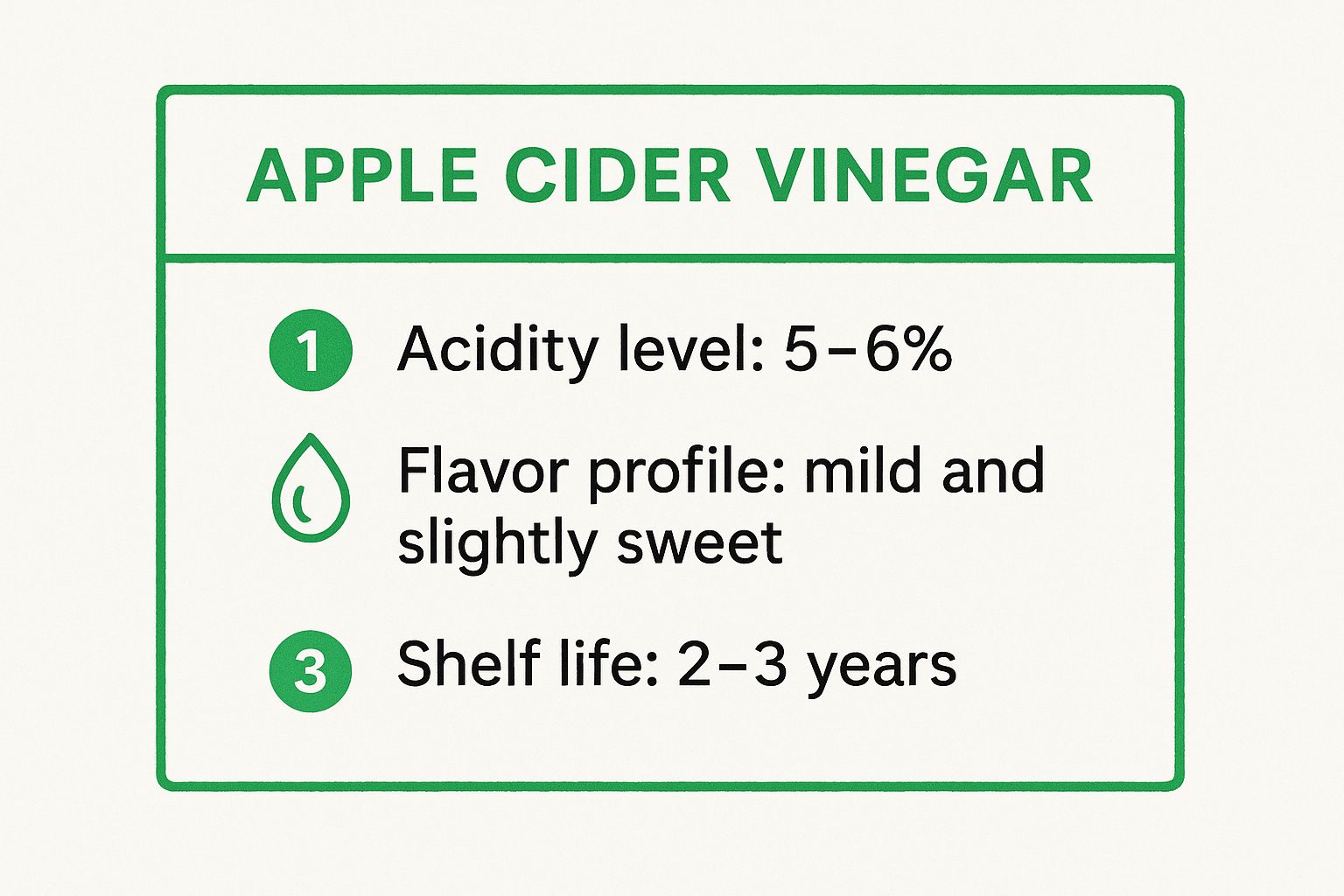That moment you reach for a bottle of white wine vinegar only to find it empty can throw any recipe off track. But what if the perfect alternative is already sitting in your pantry? This guide explores seven reliable substitutes for white wine vinegar, each with its own unique flavor profile and ideal use cases. We'll break down everything from common staples like apple cider vinegar and lemon juice to more nuanced options like sherry vinegar, providing precise substitution ratios and practical tips.
Say goodbye to last-minute store runs and hello to a well-stocked, versatile kitchen. Whether you're making a delicate vinaigrette, a tangy marinade, or a rich pan sauce, we have the perfect swap to save your dish. You might even discover a new flavor combination you love. Let’s dive into the simple swaps that will keep your cooking on track, no matter what your pantry looks like.
1. Apple Cider Vinegar
When you find yourself out of white wine vinegar mid-recipe, apple cider vinegar is likely the closest and most reliable substitute you have in your pantry. Made from fermented apple juice, it shares a similar acidity level and a mild, slightly fruity flavor profile that won't overpower your dish. This makes it an excellent one-to-one replacement in most cases, especially in recipes where the vinegar's role is to provide a bright, acidic kick.
Because of its gentle fruitiness, it’s a particularly effective substitute for white wine vinegar in salad dressings, marinades, and pickling brines. It also works beautifully when deglazing a pan to create a flavorful pan sauce or adding a tangy lift to rich sauces like hollandaise.
Key Characteristics at a Glance
For a quick reference, the infographic below highlights the essential details of apple cider vinegar, including its acidity, flavor, and shelf life.

As the summary shows, its 5-6% acidity is nearly identical to white wine vinegar, ensuring it provides the necessary tang without disrupting the balance of your recipe.
Tips for a Perfect Substitution
To get the best results when using apple cider vinegar, keep these simple tips in mind:
- Choose Unfiltered: For a more complex and robust flavor, opt for raw, unfiltered apple cider vinegar that contains "the mother."
- Taste as You Go: In more delicate preparations like light sauces or vinaigrettes, start with slightly less than a 1:1 ratio and add more to taste. The fruity notes can be more pronounced than the neutral profile of white wine vinegar.
- Shake Well: If you are using an unfiltered variety, be sure to shake the bottle well before measuring to reintegrate the sediment.
For a deeper dive into making your own vinaigrette using apple cider vinegar, check out this helpful video:
2. Rice Vinegar
For recipes that require a more delicate touch, rice vinegar is an excellent and widely available substitute for white wine vinegar. Made from fermented rice, it has a characteristically mild, clean, and slightly sweet flavor. Its lower acidity compared to most Western vinegars makes it a perfect choice when you want to add brightness without the sharp bite, preventing it from overwhelming more subtle ingredients in your dish.
This gentler profile makes rice vinegar particularly well-suited for light salad dressings, especially those with Asian-inspired flavors, and for making quick-pickled vegetables like cucumbers or carrots. It is also a foundational ingredient in many Asian marinades and stir-fry sauces, where its subtle tang complements ingredients like soy sauce and sesame oil beautifully.
Key Characteristics at a Glance
Rice vinegar’s unique qualities make it a versatile pantry staple. Its mildness is its greatest strength, offering a different kind of acidity that is less aggressive than its grape-based counterparts. Its sweetness can vary, so it's important to choose the right kind for your recipe.
Generally, unseasoned rice vinegar is the best all-around substitute, as seasoned versions contain added sugar and salt, which could alter the taste of your final dish. For more details on incorporating this ingredient into your cooking, you can learn more about how to cook with rice vinegar and other staples.
Tips for a Perfect Substitution
To get the best results when swapping in rice vinegar, keep these simple tips in mind:
- Choose Unseasoned: Always opt for unseasoned rice vinegar to control the sugar and salt content in your recipe.
- Adjust the Quantity: Since it's less acidic, you may need to use slightly more rice vinegar. Start with a 1:1 ratio and add more to taste until you reach the desired tanginess.
- Perfect Pairings: Leverage its classic flavor profile by pairing it with ingredients like soy sauce, ginger, garlic, and sesame oil for a harmonious result in sauces and marinades.
3. Champagne Vinegar
For a truly refined and delicate substitute for white wine vinegar, Champagne vinegar is an exceptional choice. Made from the same grapes used to produce Champagne, it offers a crisp, light, and subtly floral flavor that is less harsh than many other vinegars. Its production method and elegant taste profile make it one of the closest possible matches, providing a similar brightness without overpowering other ingredients.

Popularized within French culinary traditions and favored in high-end restaurants, Champagne vinegar excels in preparations where the vinegar's quality is a star component. Use it in gourmet vinaigrettes for delicate greens, light marinades for seafood like scallops or white fish, and classic French sauces. Its mild acidity makes it a perfect one-to-one replacement, ensuring a seamless and sophisticated swap.
Key Characteristics at a Glance
Champagne vinegar is celebrated for its mild acidity and nuanced flavor. It is typically a bit more expensive, making it a premium option for special dishes where its quality can truly shine.
Tips for a Perfect Substitution
To make the most of this elegant vinegar, consider these recommendations:
- Use a 1:1 Ratio: It can be used as a direct, equal-parts replacement for white wine vinegar.
- Reserve for Delicate Dishes: Its subtle flavor is best appreciated in recipes where it won't be masked by strong spices or heavy ingredients. Think light finishing sauces or simple salad dressings.
- Store Properly: To preserve its delicate notes, store Champagne vinegar in a cool, dark place or in the refrigerator after opening.
4. Lemon Juice
For a bright, fresh, and zesty alternative, fresh lemon juice is an excellent substitute for white wine vinegar. Its natural acidity provides the sharp, tangy kick needed in many recipes, while its distinct citrus flavor can brighten and lift a dish. While it’s not a neutral flavor swap, this citrus note is often a welcome addition, making it a fantastic choice for specific culinary applications.
Lemon juice works exceptionally well in Mediterranean-inspired dishes, seafood marinades, and light pasta sauces where its vibrant taste complements the other ingredients. It is a go-to for herb-based vinaigrettes, ceviche, and any recipe that benefits from a fresh, zesty finish. The key is to use it in dishes where the unmistakable lemon flavor will enhance, not clash with, the intended taste profile.
Key Characteristics at a Glance
Lemon juice offers a similar acidity level to white wine vinegar, typically ranging from 5-7%. However, its flavor profile is distinctly citrus-forward rather than the more neutral, grape-based tang of vinegar. This makes it a dynamic substitute that can add a new dimension to your cooking while still fulfilling the essential acidic role in a recipe.
Its bright flavor is best when fresh, as bottled juice often has a duller, more muted taste. The powerful acidic properties of lemon juice also make it a fantastic natural cleaning agent. You can even explore how its acidity helps clean tough kitchen items.
Tips for a Perfect Substitution
To achieve the best results when using lemon juice as a substitute for white wine vinegar, follow these guidelines:
- Always Use Fresh: Squeeze lemons fresh for the brightest and most authentic flavor. Bottled lemon juice can have preservatives that alter the taste.
- Start with Less: Because of its potent flavor, begin with about half the amount the recipe calls for in vinegar and adjust to taste. A 1:1 ratio can sometimes be overpowering.
- Add at the End: For cooked dishes, add the lemon juice just before serving. This preserves its fresh, vibrant flavor, which can diminish with heat.
- Balance with Oil: In vinaigrettes, pairing lemon juice with a neutral oil like grapeseed or a mild olive oil helps mellow its intensity and create a balanced dressing.
5. Sherry Vinegar
For a substitute with more depth and complexity, sherry vinegar is an excellent and sophisticated choice. Produced from sherry wine in the Jerez region of Spain, it offers a rich, nutty, and slightly sweet flavor profile that is more robust than white wine vinegar. Its moderate acidity still provides the necessary tang, but it also introduces a layer of warmth and character that can elevate a dish from simple to standout.
This unique flavor makes sherry vinegar an exceptional substitute for white wine vinegar in recipes where you want to add a distinctive, savory note. It is particularly brilliant in Spanish dishes like gazpacho, marinades for rich meats like pork or duck, and drizzled over roasted vegetables. A warm bacon vinaigrette made with sherry vinegar is another classic application where its complex taste truly shines.
Key Characteristics at a Glance
Sherry vinegar's unique profile sets it apart, offering a complex balance of acidity and deep, nutty flavors. While it's a fantastic substitute, its distinct character is something to consider when making the swap. Its rich, aged quality brings a unique dimension that is less neutral than standard white wine vinegar.
Its typical acidity hovers around 7%, slightly higher than white wine vinegar, so a little can go a long way in providing the acidic punch your recipe needs.
Tips for a Perfect Substitution
To make the most of this flavorful vinegar, keep these tips in mind:
- Start Small: Due to its assertive flavor, begin with a 1:1 ratio but taste as you go. You may find you need slightly less to achieve the right balance.
- Look for Authenticity: For the best quality and flavor, look for bottles with the 'Vinagre de Jerez' designation, which guarantees its origin and aging process.
- Pair with Bold Flavors: It works beautifully when combined with robust ingredients like olive oil, garlic, paprika, and herbs, making it ideal for grilled or roasted foods.
6. Red Wine Vinegar
When you need a substitute with a bolder personality, red wine vinegar is a fantastic choice. Produced from fermented red wine, it carries a more robust and fruit-forward flavor profile compared to its white wine counterpart. While its distinct tang and rich color make it a less direct replacement, it excels in dishes that can handle a punchier acidic note.
Its assertive flavor makes it one of the best substitutes for white wine vinegar in hearty recipes. It shines in marinades for red meat like beef or lamb, bold vinaigrettes for salads with dark greens, and Mediterranean-inspired vegetable dishes. If your recipe includes other strong flavors like garlic, herbs, or olives, red wine vinegar will complement them beautifully.

Tips for a Perfect Substitution
To ensure red wine vinegar enhances rather than overpowers your meal, follow these guidelines:
- Be Mindful of Color: Red wine vinegar will impart a reddish or purplish hue to your food. Avoid using it in light-colored dishes like cream sauces or chicken preparations where appearance is key.
- Start with Less: Due to its stronger flavor, begin by using about three-quarters of the amount called for in the recipe. You can always add more after tasting to achieve the right balance.
- Embrace Bold Pairings: This vinegar pairs exceptionally well with robust ingredients. Use it confidently in recipes featuring strong herbs like rosemary and oregano, or in hearty grain salads.
7. White Distilled Vinegar
When you need a substitute for white wine vinegar that delivers a powerful acidic punch, white distilled vinegar is a common household staple that gets the job done. Made from distilled grain alcohol, it has a very sharp, clean, and potent flavor. It lacks the subtle, fruity complexity of wine-based vinegars, so it's not a direct one-for-one flavor match, but its strong acidity makes it useful in specific applications.
This vinegar's intense profile makes it one of the best choices for pickling vegetables, where its high acidity acts as an effective preservative. It's also suitable for baking recipes that call for vinegar to react with baking soda for leavening. In dressings or marinades, its harshness needs to be mellowed, but it can work in a pinch when properly diluted or balanced with other strong flavors.
Key Characteristics at a Glance
White distilled vinegar stands out for its high acidity and neutral, albeit sharp, taste. Its primary role is to provide acidity without adding complex flavor notes, making it a functional rather than a nuanced choice. Its straightforward nature is its main strength, especially when a strong acidic component is the primary requirement.
Tips for a Perfect Substitution
To successfully use white distilled vinegar as a substitute, it's crucial to manage its intensity. Keep these tips in mind:
- Dilute for Balance: Due to its higher acidity (often 5-10%), dilute it with a bit of water (try a ratio of three parts vinegar to one part water) to better mimic the gentler profile of white wine vinegar.
- Start with Less: Begin by using about half the amount the recipe calls for, then taste and adjust. Its potent flavor can easily overwhelm a dish if you're not careful.
- Infuse with Flavor: To add some of the complexity it lacks, infuse the vinegar with herbs like thyme, rosemary, or a crushed garlic clove for about an hour before using it.
- Best for Pickling: Embrace its strength in pickling brines. Its clean, potent acidity ensures crisp, well-preserved pickles without adding competing flavors.
7-Way Comparison of White Wine Vinegar Substitutes
| Substitute | Implementation Complexity 🔄 | Resource Requirements 💡 | Expected Outcomes ⭐📊 | Ideal Use Cases 💡 | Key Advantages ⭐⚡ |
|---|---|---|---|---|---|
| Apple Cider Vinegar | Low — easy 1:1 substitution 🔄 | Widely available, no special prep needed 💡 | Mild acidity with slight sweetness ⭐📊 | Salad dressings, marinades, pickling, sauces | Health benefits, mild flavor, versatile ⭐ |
| Rice Vinegar | Low — simple substitution 🔄 | Common in Asian markets, unseasoned preferred 💡 | Delicate, mild acidity, less sharp ⭐📊 | Asian dishes, sushi rice, light dressings | Milder taste, complements delicate foods ⚡ |
| Champagne Vinegar | Moderate — premium product 🔄 | Less available, higher cost 💡 | Closest flavor match to white wine vinegar ⭐📊 | Fine dining, French cuisine, gourmet recipes | Elegant flavor, premium quality ⭐ |
| Lemon Juice | Low — direct fresh juice use 🔄 | Requires fresh lemons, short shelf life 💡 | Bright acidity with citrus flavor ⭐📊 | Mediterranean dishes, seafood, fresh preparations | Readily available, fresh brightness ⚡ |
| Sherry Vinegar | Moderate — aged vinegar 🔄 | Moderate availability, some cost 💡 | Complex, nutty flavor with moderate acidity ⭐📊 | Spanish/Mediterranean cuisine, rich dishes | Adds depth and sophistication ⭐ |
| Red Wine Vinegar | Low — straightforward use 🔄 | Widely available, affordable 💡 | Robust acidity with strong flavor ⭐📊 | Hearty dishes, red meat, dark salads | Strong acidity, good shelf life ⚡ |
| White Distilled Vinegar | Low — requires dilution/pairing 🔄 | Very widely available, cheapest 💡 | Very strong acidity, sharp taste ⭐📊 | Pickling, cleaning, diluted dressings | Highest acidity, clear, very affordable ⚡ |
Mastering Flavor: Making the Right Substitution
Navigating the kitchen without a key ingredient doesn't have to be a setback. As we've explored, finding effective substitutes for white wine vinegar is an opportunity to fine-tune your culinary instincts and discover new dimensions of flavor. The right choice depends entirely on the context of your dish, turning a simple swap into a thoughtful culinary decision.
Your main takeaway should be this: context is king. The bold, fruity notes of red wine vinegar that work beautifully in a beef marinade would easily overpower a delicate fish dish, where the subtle acidity of champagne vinegar or the clean zest of lemon juice would shine. Likewise, the mild, slightly sweet character of rice vinegar is perfect for a light vinaigrette but might get lost in a hearty, cooked-down sauce.
Key Principles for Successful Swapping
To ensure your dish turns out perfectly every time, remember these core principles:
- Consider Acidity and Flavor: Is the vinegar's primary role to provide a sharp acidic bite, or is its unique flavor profile essential? For pure acidity, distilled white vinegar or lemon juice can work. For nuanced flavor, options like sherry or apple cider vinegar offer more complexity.
- Taste as You Go: This is the most crucial step. Always start by adding about half to three-quarters of the substitute, then taste. You can always add more, but you can't take it away. Adjust until the balance of acid, salt, and sweetness is just right for your palate.
- Think About Color: In pale sauces, glazes, or dressings, a dark substitute like red wine vinegar will alter the final appearance. For visually sensitive recipes, stick to lighter-colored alternatives like rice vinegar or lemon juice.
Mastering these substitutions will not only rescue a recipe in a pinch but will also make you a more confident, adaptable, and creative cook. You’ll begin to see ingredients less as rigid requirements and more as flexible components, empowering you to put your own unique spin on any dish you create.
Tired of scrambling for substitutions? Stay organized and build your perfect recipe library with Recipe One. Capture any recipe from across the web, add your own notes on successful swaps, and create a personalized cookbook that’s always at your fingertips. Get started for free at Recipe One.

